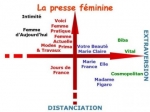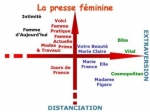Usage creates innovation: future is local
 Globalization is only a technician’s point of view – at least an industrial necessity. But certainly not a consumer need. An usually widespread idea is that tomorrow, life will be “standardized” all around the world because technology will be “standardized”: we’ll use the same computers, the same mp3 players, etc. we’ll become identical from London to San Francisco and from Berlin to Atlanta, doing the same thing with the same objects.
Globalization is only a technician’s point of view – at least an industrial necessity. But certainly not a consumer need. An usually widespread idea is that tomorrow, life will be “standardized” all around the world because technology will be “standardized”: we’ll use the same computers, the same mp3 players, etc. we’ll become identical from London to San Francisco and from Berlin to Atlanta, doing the same thing with the same objects.
But it’s not because we have the same mp3 players or the same cell phones in hand that we use them in the same way: teenagers in Paris, Tokyo and Beijing don’t have the same usage of their mobile phones for instance. And globalization doesn’t appear as the objective for teenagers: for them, life will be different, somewhere between local and global – but certainly more local than global.
Innovation and globalisation
Economy becomes more and more global, especially in high tech industry: there are no more local computer, television or cell phone manufacturers – only local assemblers, essentially working for retailers. All the leading companies – Sony, Samsung, Dell, Hewlett Packard, Nokia, etc. operate at a worldwide level. Consolidation goes really quickly, generally by external growth, leaders buying their challengers.
In most cases innovation appears as the main driver, as for the cell phone industry: cell phone industry is an extremely recent one where technicians establish worldwide standards in order to have the possibility to sell the same products in Paris, London or New-York. When there is no past, no history, it’s quicker and easier for the whole industry to act in a same and common direction.
Television is an old high tech industry – more than half a century! Transition from black and white to color abolished some differences in Europe, mainly between French Secam and German Pal. But some divergence remained – for instance at a global level, with American NTSC. Today new transition to flat screens (LCD, PDP) and to High Definition (Mpeg 4) accelerates worldwide unification.
This recent phenomenon coincides with the development of digital. Clearly, digital speeds up innovation and globalization: 30 years ago, the first experiments of analog High Definition television failed pitifully, mainly because European and Japanese industries dashed into a wild and total competition, refusing any discussion. Remember the story
In 1972, NHK, the main Japanese TV channel, starts research on High Definition television, supported by the government; 1984: European Broadcasting Union gives its agreement to the standard D2 Mac Paquet, developed by France Telecom and Deutsche Telekom. 1986: Japan submits their HiVision to the Consultative Committee for International Radio, but not compatible with American NTSC.
European industries improve the development of D2 Mac Paquet with new HD MAC whereas Japanese HiVision is modified to a NTSC compatible version: Muse. But American government starts at the same time initial research on digital TV.
Millions $ will be invested and simply lost: In 1993, in front of the obvious failure of the standard, Philips and Thomson abandon D2 MAC, as do the Japanese the following year with Muse. It will be necessary to wait until 2006 and the football world cup in Europe for High Definition television to really begin.
Digital High Definition television. And thanks to a global standard based on Mpeg4. Digital drives innovation. And innovation drives innovation.
Nevertheless, even with digital, everything is not perfect and sometimes industry plays again and again the same old song – repeating the same mistakes: today DVD recorders multiply non compatible standards as did 30 years ago the VCR with JVC’s VHS, Sony’s Betamax and Philips’ V2000.
However the story began very well: when the first devices arrived on the market in 1997 in France, it was under the best auspices: a single standard, the praises of the press, a promising future in spite of high prices. Only two shadows in the picture: an unofficial format called DivX, allowing burning a film onto a simple CD; and the Chinese preference for the competitor Video CD.
But DVD was not burnable. With the launch of the first burners, there started a new war between more or less compatible standards: consumers had to learn the differences between DVD +R, DVD + RW, DVD RAM and DVD-R /-RW! Good luck! And moderators heard again and again the same complaints during focus groups: “I remember what my father said about his old Betamax.” A never ending story!
DVD size is too small to burn a film in High Definition quality: unluckily, if the next generation of burners will strongly improve quality, it will not correct the error of the previous one: the war is always so violent between Blu-ray and HD-DVD whereas Chinese want to launch their own standard, called EVD.
Nevertheless the dominating trend is industrial globalization, with the emergence of quasi-monopolies: how many brands in cell phones’ industry, how many for computers? On this last market, globalization is more in the components: if there are a lot of local makers – essentially working for retailers – for the chip, you just have the choice between Intel and AMD.
Because high tech products are the same from one extremity of the planet to the other, high tech globalization is quickly on its way: citizens use the same machines, in the same way, there are less differences between a teenager in Tokyo and in Sao Paolo than between this teenager and his grandfather! Technology standardizes our world.
In this global game, some countries are more important than others: cell phones, LCD televisions, mp3 players, everything comes from Akihabara in Tokyo – as it was the case for luxury and perfumes in Paris. Japanese teenagers show the direction to a global young generation: tomorrow we’ll use the products they buy today. Knowing the high tech future is easy: we see it in Akihabara streets!
Innovation is usage
That’s what high tech managers think – or still try to think. But reality, as it appears more and more often, is completely different. In this paper our approach will be mainly based on observation of failures and successes, and then questioning people to explain these failures and successes and understand the evolutions of their day to day practices.
Failures are not exceptions, as for the DVD recorders: reality is more the opposite. Best case is certainly the 2.5 generation on cell phone market.
GSM was the second generation for cell phone, the transition from analog to digital, but limited to voice. UMTS will be the third generation with high speed communication for voice, data and images. Between GSM and UMTS, 2.5 generation was seen as a great improvement, optimizing immediately GSM possibilities with data and images.
Called i-mode in Japan, 2.5 generation became a great success: teenagers immediately bought i-mode cell phones – and used i-mode services: to discover the best restaurant in the street, to know the location of the latest fashionable disco, to send messages to their friends and reply to their parents, etc.
Called WAP in France (for Wireless Application Protocol), 2.5 generation was a disaster because in our country nobody wanted to carry in his pocket a mini computer to connect to Internet, to chat, to surf in the street: speaking with friends, or informing them of a delay was enough.
Technique is less important than usage: therefore WAP didn’t succeed in Europe. Usage creates innovation – not engineers! The real innovation – and success – of the last five years is SMS. However SMS is not a technical innovation, neither a marketing innovation: no telecom operator believed in such a product. But the younger generation used them a lot: why?
Communication has completely changed since the beginning of the 21st century. Last century was marked by the transition from closed systems as in the little country villages to open systems as described by Palo Alto researchers; but now the younger generation is moving to less and less structured systems, without constraint at all. We’ll come back on this point.
Consumer is the real creator of the products he uses… and sometimes it’s surprising. Surprising for engineers when he gives sense to products in which they do not believe, as SMS: SMS is a very poor system of communication, especially when you can add pictures and data to the voice!
Surprising when users transform a product into another. Recently a French telecom operator experimented with mobile television on a cell phone: 185 persons received a nice terminal – the same size as a normal cell phone with a wonderful LCD screen.(*) The main purpose of the test was to discover where and when people would watch television : at the hairdresser’s, at the office, waiting for somebody in a bar, etc.
Positive surprise: 84 % of the users think that the mobile telephone is well adapted to television. Quality of image and sound are approved by a large majority – respectively 98 % and 95 % of satisfied users. News appears as the most relevant program for telephone, ahead of music and weather reports.
But the real surprise comes from the place and time where people look at television on their mobile phone: 70% watch it by night… at home. For them, this kind of telephone is above all a second TV set! A nice tool to watch the end of a soccer game in bed, without annoying his spouse.
From a methodological point of view, it’s no more possible to conduct consumer research as usual. Imagine: you write a nice concept board about mobile television; you moderate a qualitative group with early adopters – to be sure they will correctly understand the product – and you try to know when and where they will watch this television.
“In a coffee shop, waiting for a friend” or “In a bus, on my way to my office”, etc. They will imagine all situations – the same situations engineers and marketers would imagine too. Mistake: in real world, they’ll use it at home, in bed!
When you question somebody about usages he could have, he necessarily answers with his semantic memory – where concepts are built and analyzed; but his life leaves its own traces somewhere else: in his episodic memory. This is why nobody can really imagine what their future will be: nobody can anticipate something in episodic memory with semantic memory.
The only pertinent way to determine what is an innovation or not, is look at citizens’ behavior: it’s why we researchers today replace more and more in depth psychological interviews or focus groups with ethnology and pure observation. To understand what “connectivity” really means for consumers today, it’s more relevant to visit them at home and see their practices and solutions.
It’s what we did at Thomson last year. First we identified Young couples without children and Young parents as key targets for connecting products because as all young people, they are deeply involved in computing and nomadic digital products; and at the same time they start a new life where home and family become more and more central, including television.
They have a lot of music, photos, videos they like to share with friends: to understand how they achieve it, we sent an ethnologist with a cameraman to visit 12 homes and discuss this point with them: “Tell me how you show all your pictures to your friends?” The reality is amazing: they take a lot of photos… they never look at, neither alone, nor with someone else.
And when you ask them why they don’t connect for instance their camera to the TV set, they reply: “I didn’t know it was possible”! However we are questioning early adopters, high tech lovers but their behaviors are totally unexpected: they photograph all the time with their cameras, webcams or cell phones, select only a few pictures which they send to all the addresses they have in their mail box, then they forget them.
Another example: in 2004 we had to understand consumer concerns and expectations towards video recorders with built in hard disk drive. These kinds of products are like a VHS video recorder, but the tape is replaced by an hard disk drive: it facilitates recording (you can easily record hours of program); another advantage is the time shifting: you can “pause” a live program, answer a call, and start again thanks to a temporary recording on the hard disk.
We organize qualitative groups amongst early adopters and time shifting appears as the most appreciated feature: so fascinating! Then we gave a prototype to each attendee and questioned them after two weeks: time shifting was no more a useful feature because it breaks the domestic cohesion. Conversely they approved by a large majority the ease of recording: reality of use completely changes the perception and the destination of the product!
Global or not global
Two opposite movements cross our civilization, one bound to technological innovation, the other to usages engendered by this innovation: the point is to know if worldwide high tech products will necessarily generate global usages or if usages will nevertheless remain local and convert global innovative high tech products into local products. Which one is the most powerful trend?
If it’s the first one, the whole planet will act tomorrow in the same way: we’ll listen to the same music on the same mp3 players, watch the same movies on the same LCD TV sets, drive the same cars thanks to the same GPS Navigation System. Some differences will remain: British citizens will continue to drive on the left side and French ones on the right, and German movies will be translated – at least shown with subtitles – on Japanese television; but music is already global and Japanese teenagers listen to Franz Ferdinand or Placebo as do French or American ones: since Elvis Presley and the Beatles, rock and roll is universal and the language doesn’t matter.
Actors eat the same food in movies we see on our TV sets when we are having dinner at home – and we choose the same meals in restaurants afterwards: Chinese or Italian food is no more exotic food – just a part of global food: there are so many Chinese or Italian restaurants in New-York, Paris or Sidney! That’s what the great majority of futurologists think.
But if the second is the most powerful trend, we’ll use in totally different ways the same global products: TV sets, cell phones, microwave ovens will be identical in Paris or in Tokyo – coming from the same factories in Korea or China – but we’ll eat different meals, watch television in different ways, we’ll call our friends for different reasons – not at 4 PM to have a cold dinner with a glass of beer at 6 PM in front of a baseball program!
Changes are quicker amongst young teenagers than mature citizens: you accept more easily the changes when you don’t have too many anchored customs. Evaluate the power of these two movements – technology versus usage – through two symbolic products of this generation: mp3 players and mobile phones.
mp3 is certainly one of the most successful products of the last ten years: every teenager has one: thye can’t live without one. All teenagers walk or cycle in the streets of Berlin, Seoul or Chicago with their player in their pocket, the earphones plugged into their ears, listening to the Artic Monkeys, Franz Ferdinand and/or Eminem: music and music players are global – and usages too.
Yes. And No! And conclusions are certainly more complex!
Music was global before mp3 and mp3 players: Mozart or Bach were played at the courts of all the European kingdoms, and then listened to by the whole European bourgeoisie; they were as popular at the opera in Paris as in Moscow. During the second part of the twentieth century, radio boosted the explosion of the rising music, but didn’t create the love of the music amongst young generations.
The Beatles – according to the famous word from John Lennon – were more famous than Jesus Christ, not because radio broadcast their music but because their music expressed the rebellion of a whole generation to the consumer society; today Placebo or Franz Ferdinand are not famous because their songs are shared on Internet but their songs are shared on Internet because they are popular. Because, since Elvis Presley, rock and roll is (one of) the music of the young people!
And Eminem? Eminem is certainly the best example. Because Eminem is not rock and roll but rap: rap is another kind of rebellion and contestation, more spontaneous than rock and roll today. Rap exists in all suburbs over the world, at least in developed countries: rap is the music of the young and poor tribes in America, Eminem comes from Detroit. If Eminem is a well known star now, it’s because he personifies a certain kind of revolt against establishment. A common revolution for all poor young people.
At the same time, rap is the link gathering a tribe living in the same suburb: viewed from this angle, rap is no more global, only micro-local. And the boys who listen to the same music on the same Boom Box (big portable audio system) as the boys of the next street don’t share anything with them: they don’t belong to the same tribe; they don’t live in the same world – because their world stops at the corner of the street!
Technology supports musical globalization – but doesn’t create it. It’s not because young boys, all over the world have the same mp3 players or the same Boom Boxes that they share the same values, the same expectations. Reality is exactly the opposite: it’s because music was global first that it became so rapidly global. Culture before high tech.
Same analyze for cell phones: in this case, technological innovation was 50 years late versus civilization! Or even more!
When western countries were more or less agricultural, villagers met every day on the main square of the village; when they had to discuss, they walked easily from one house to another. In the small towns, it was not really more difficult; even in Balzac’s books, at the middle of the 19th century, Parisians walked continuously from one district to another: big cities remained human.
After the drift from the land, cities became suddenly too big: it was no longer possible to keep in touch with all ones friends or relatives. The telephone helped to fix appointments: nobody spends one hour in traffic jams if they are not sure to meet the people they want to speak to. It lacks flexibility but it’s nevertheless a great progress.
Towns become bigger and bigger. Too quickly: we lose hours in buses or in traffic jams, and people regret the “good old times” when it was so easy to cross the village main street to find friends in a bar.
Cell phones give back this lost flexibility: wherever you are, you can reach your friends and decide how to meet them; if you are late in a traffic jam, you can call and inform your friends you are coming.
When you ask consumers about mobile phones, they don’t answer: “What a great idea”, but: “Why did nobody do it before?” Yes, why: in all countries, cities became too big during the last century, it was urgent to design something to help their inhabitants. Mobile phones became immediately global because the problem was common to all countries: all cities were too big, too inhuman.
Again, technological innovation doesn’t create globalization but follows it.
Usage is local
Even if technological innovation doesn’t create globalization, it could accelerate it? Technological innovation could standardize usages – convert local usages into global usages. However the opposite seems more evident: local usages, local ways of life slow down globalization. Cell phones appear again as the best example.
We wrote above that i-mode became immediately a great success in Japan while WAP was a total disaster in France. However cell phones were as successful in Japan as in France: why its upgrading diverged from one country to another? Because in spite of appearances, the Japanese and the French use telephones in different ways. Even if they live in gigantic cities, people from Paris and Tokyo are more different than similar.
As in Tokyo, Parisians needed tools to fix appointments with their friends at night and / or to advise them they would be late because of traffic jams, for instance – and it’s why cell phones appeared as a great idea in Europe as well as in Asia.
A traffic jam is a good reason to call the person you are going to meet – even if it’s dangerous to call whilst you are driving! There are so many traffic jams in Paris between 5.PM and 7.PM; after 8.PM driving becomes easier in our country… but not in Tokyo: there, traffic never stops before midnight.
Why? Because Japanese people don’t live at home, like us, but outside, in streets, bars, restaurants – everywhere, but not at home. At least, men and young women: when they have children, mothers stay definitively at home, often with grandparents – Tokyo misses flats and flats are so small that often three generations live in the same place without real intimacy!
And men don’t stay home, they prefer to spend the night in bars and restaurants with friends and colleagues. Japanese people don’t live outside because their flats are not really convenient, it’s more the opposite: they don’t need bigger flats because they prefer to live somewhere else. It’s not a recent phenomenon: even when there were no cars and no jams in Tokyo, Kyoto, Osaka or Kobe, men spent their time in bars. For them, bar-maids were as important as their own wife: Kafu in Tsuyu no atosaki (**) tells Kimie’s story, barmaid in Ginza… in 1931!
Japanese life changed after the beginning of the last century – as French life did too. But not their fundamental bases: Japanese men return home very late – streets, bars, restaurants are their real homes! And they need Internet tools in their pocket exactly as we need Internet tools at home: they order a book at Amazon in a bar with their cell phone exactly as we do… only at home on our computer.
Young people modify their habits more quickly: in appearance, they are as nomadic in France as in America as in Japan. But even with an i-mode cell phone in their pocket, Parisian teens prefer to send and receive e-mails or order goods via Internet at home than outside: even having an i-mode cell, they keep their habits – high tech products don’t change usages if there is no fundamental need.
Sometimes French teens need a quicker communication than e-mails – but very limited communication: just few words to fix an appointment or to say hello to a good friend – no answer needed in this last case. It’s why French teens use SMS a lot: just a way to keep in touch to close friends, immediately and in an extremely easy way.
For many reasons usage will remain local. Television for instance: news on TF1 and France 2 – the two main French TV channels – starts at 8.PM every night and at 6.PM on BBC1 from Monday to Friday, and later during the weekend, in the UK. Even in front of a wonderful High Definition plasma screen, English people will continue to watch the news at 6.PM with a cold dinner while their French cousins will prefer a more substantial meal later.
Main television is sometimes in the kitchen in the UK – a bigger kitchen than in France – and in the basement in America, with a billiard table or other games: there is no problem of space, and people in the Midwest generally buy impressive projectors. In Japan, it’s exactly the opposite and it explains the success of LCD television – and at first mobile television too! High tech innovation will not change historical usages… and the size of the flats too!
Tomorrow will be local
Even if high tech innovation will not change the size of the flats, maybe it could modify habits and usages which are not linked to fundamental patterns – as outdoor life in Japan. And certainly the young generation is the most capable of changing, they have no prejudices: we’ll have to investigate the relationships between teenagers in France, to understand what the principal trends are and if these trends go towards globalization or not.
But before, let’s consider the last trends on Internet, independently of any consideration for age or other socio-demographics. At its start Internet was designed as global: the best solution to improve scientific exchanges between researchers, between universities. Languages appeared as the main barrier to globalization – and today, encyclopedias as Wikipedia are available in many languages even if the concept is global.
Nevertheless the first trend was global – the myth of the Global Village. But today, the village becomes more and more local – as a real village. New communities, new sites arise everywhere, sites whose content is to bring together people of the same district: neighborhood networks to share with close people, from the same street, even the same house!
Recently in a popular district of Paris a new site appeared called: Peuplades – Tribes in English. The purpose was to help people living in the same area to meet and to develop communities: for baby sitting, for cultural trips, for wine lovers, etc. Last tribes: the musicians of the Epinettes, the data processing specialists in Montparnasse, the housewives from Place de Clichy, etc. The Epinettes, Montparnasse, Place de Clichy: as many small areas in Paris!
Peuplades.net is growing very fast. Other communities are born here and there, more and more often based on blogs. What is a blog? “Short for Web log, a blog is a Web page that serves as a publicly accessible personal journal for an individual. Typically updated daily, blogs often reflect the personality of the author”, according to Wikipedia.org.
“Knitting wool passion” helps ladies who like to make their own clothes; “It’s in Besançon” indicates the main events coming in this town; and on “Paris 16th”, we learn that: “Psyreso association proposes next Tuesday at 8.PM a discussion about: how to loose weight thanks to psycho”. Internet becomes more and more the best solution to solve local problems.
Teenagers love blogs too – they use them a lot: more than 4 millions teenagers’ blogs on Skyblog in France; Skyblog is the Internet site of one of the most popular Rap radio stations in our country. And again, all these blogs appear local, immediately local: some do not exceed the limits of one college. But in reality these blogs are neither global, nor local: they are somewhere else, in another dimension.
Tomorrow will be somewhere else
Blogs illustrate one of the most important changes in our society, in terms of communication.
To understand what’s going to happen tomorrow, we have to explain what happened yesterday when our civilization moved from a country life to an urban life: our society faces today a fundamental change, exactly as one century ago, when life and communication were only local – but moving to global.
Living in a village is living in a closed community: you must accept and respect many rules – non-written rules, imposed by tradition. For instance, a young lady can’t stay alone with a man: if she does such behavior, she will be seen as a loose woman. If you live in a Christian village, you have to go to church on Sunday: if not, you will be quickly suspected of all wrong-doings, etc.
In a town, you belong to different communities: your family, your colleagues, your friends, etc. Rules are different from one group to another and your behavior can easily change too: a subjected husband at home will become a grumbling director at his office and a really charming friend in a pub. If this person becomes grumbling with his friends, he will lose them: to remain in this group, he has to accept its rules, as in the previous village. But he can move from one group to another, it’s really easy in a bigger town.
It’s why Palo Alto Group calls these communities open systems: as the closed system from the 19th century, strong rules link members of a same group – but everyone is free to change, to move from one group to another:
“Human interaction is described as a communication system, characterized by the properties of general systems: time as a variable, system-subsystem relations, wholeness, feedback, and equifinality. On-going inter-actional systems are seen as the natural focus for study of the long term pragmatic impact of communicational phenomena”.(***)
If one member doesn’t respect the rules of his group – his system – he will be quickly excluded from the group; if 10% or more of the members don’t respect the rules, the group will explode.
Some rules are specific to each particular group, but some are common to all groups – as defined by Palo Alto: wholeness, feedback or equifinality, etc. A system not governed by these rules is not stable – it will be rapidly destroyed. For instance, a system where there is no feedback is either a dictatorship, or a non-system; just a juxtaposition of persons without communication.
Each citizen, in any country, belongs to several local groups – or systems: his neighbors, his family, his friends, etc. His job too, very often: he goes to his office, meets colleagues, clients, etc. But when you are senior manager in an international company, you have to manage employees in different countries, you have to take the plane to meet colleagues in America or Russia, etc. One of the different systems you belong to is global.
Between local and global, there’s national, continental system: when you look at the news on TF1 or RAI 1, you become a member of a broad French or Italian community, even if the feed back is poor: you just have the right to turn off your set if you disagree, and now you can answer with SMS.
We all belong to different communities – systems according to Palo Alto definition. And some of these systems are local, others are national or global. And because communication is system, and system is communication – still according to Palo Alto definitions – we take part more and more in national and international communities: television and now Internet.
The first communities which arose on Internet respected Palo Alto rules: often a moderator helped members; and the one who didn’t play the game could be excluded for the protection of the group itself. And the first blogs developed by American journalists respected Palo Alto rules too, reporting the same news as the traditional media, but with another analysis, another point of view.
The main difference between blogs and mass media was the quality of feed-back: on a blog, you can react, discuss, and develop contradictory opinions. A journalist blog in America, or now in Paris, is a national or multinational system, respecting Palo Alto rules.
The teenagers’ blogs are different: they don’t respect any rules. First there is no real feed-back: everyone is invited, everyone can do what they want – even tags, modify the existing blog. Blog is an object which doesn’t really belong to its creator.
These blogs don’t respect the main property of general systems: wholeness. Blogs are the zero degree of community – as SMS are the zero degree of communication: the borders are not known, even by its first designer. It’s not like a body – the best image is certainly the synopsis: something “long-winded”, the possibility for “people” to establish “contact” and stay in touch. Temporarily.
Blogs are not the only or the first system to not respect Palo Alto rules: for instance flash mobs are similar: “A flash mob is a group of people who assemble suddenly in a public place, do something unusual for a brief period of time, and then quickly disperse. They are usually organized with the help of the Internet or other digital communications networks”, according to Wikipedia. (****)
Teenagers’ blogs or flash mobs are certainly not global; they are not local too, they are somewhere else. But they are more local than global… or more precisely non-global: there is no worldwide ambition in these new communication tools – just the possibility to express, react, share.
At the end of the 19th century our civilization moves from closed systems to open systems: people stood at the connection of different communities – some local, some national, some global. Our civilization moved from traditional villages to global villages – with “s”. But this evolution is only possible if open systems are stable – when they are systems: globalization needs stability.
Today in the 21st century, emerging trends are less and less stable communities – more temporary systems linked to opportunities. Teenagers are looking for more humanity – and humanity is local. Therefore globalization will mark time. Certainly “some globalization” is irreversible but it’s no more the major trend. Local networking and communication will lead society during this century.
Paper to be published in: Innovative technology, Cambridge Scholars Press – 2006
Thank you to Mike Davison for his support.
* http://www.institutionnel.bouyguestelecom.fr
** Kafu: Tsuyu no atosaki, Hisamitsu Nagai, 1931
*** Paul Watzlawick and al. – Pragmatics of Human Communication: A Study of Interactional Patterns, Pathologies, and Paradoxes, Norton & Company, 1967
**** http://en.wikipedia.org/wiki/Flash_mob


 The purpose of this paper is to show how accounting for the most recent developments in such a qualitative subject as semiology can profoundly alter the patterns of a quantitative discipline such as media planning.
The purpose of this paper is to show how accounting for the most recent developments in such a qualitative subject as semiology can profoundly alter the patterns of a quantitative discipline such as media planning. The Bicentennial of the French Revolution produced a considerable number of televised events.
The Bicentennial of the French Revolution produced a considerable number of televised events. Cosmopolitan also featured an interview with Fanny Ardant, but took care not to mention her return to television.
Cosmopolitan also featured an interview with Fanny Ardant, but took care not to mention her return to television. Extraversion
Extraversion Each advertisement was a complete discursive manifesto, fully updateable on all four levels as defined by Umberto Eco. Thus, at actancial level, the American Express advertisement was interpreted as a story with three actors: a hero, the young man in the foreground, the woman, whom the man is seeking to win, and alongside him, the waiter, absent but obviously necessary to understand the message properly.
Each advertisement was a complete discursive manifesto, fully updateable on all four levels as defined by Umberto Eco. Thus, at actancial level, the American Express advertisement was interpreted as a story with three actors: a hero, the young man in the foreground, the woman, whom the man is seeking to win, and alongside him, the waiter, absent but obviously necessary to understand the message properly. The Radiola advertisement is receptive to the same sort of analysis; however, the values underlying its comprehension at the deepest levels differ completely. The advertisement presents two actors: the washing machine in the role of the hero, and a user, visible only via her arm.
The Radiola advertisement is receptive to the same sort of analysis; however, the values underlying its comprehension at the deepest levels differ completely. The advertisement presents two actors: the washing machine in the role of the hero, and a user, visible only via her arm. The Extraversion pole is always surrounded by advertisements in which the views of other people weigh very heavily through values of simple ostentation, like American Express, and through a clearly stated commitment to provocation, as Kookaï.
The Extraversion pole is always surrounded by advertisements in which the views of other people weigh very heavily through values of simple ostentation, like American Express, and through a clearly stated commitment to provocation, as Kookaï. Our intention is to deal with the advertising message and more particularly with the influence several different vehicles may exert on its perception within one and the same medium: for instance women’s magazines.
Our intention is to deal with the advertising message and more particularly with the influence several different vehicles may exert on its perception within one and the same medium: for instance women’s magazines. The Gatineau advertisement, highly elitist, transforms the product, presented majestically as a sign of social recognition. Women who buy this brand of beauty product primarily gain satisfaction from the way they are viewed by others, hence a Reading Mood combining Extraversion and Distance.
The Gatineau advertisement, highly elitist, transforms the product, presented majestically as a sign of social recognition. Women who buy this brand of beauty product primarily gain satisfaction from the way they are viewed by others, hence a Reading Mood combining Extraversion and Distance. Cet exposé a pour objet de montrer comment la prise en compte des développements les plus récents d’une discipline aussi qualitative que la sémiologie, risque de modifier profondément les habitudes d’une discipline aussi quantitative que le média-planning.
Cet exposé a pour objet de montrer comment la prise en compte des développements les plus récents d’une discipline aussi qualitative que la sémiologie, risque de modifier profondément les habitudes d’une discipline aussi quantitative que le média-planning. Le Bicentenaire de la Révolution Française fut prétexte à multiples événements télévisuels.
Le Bicentenaire de la Révolution Française fut prétexte à multiples événements télévisuels. C’est autour des ces deux personnalités que se construisent les deux articles. Un court récit de deux pages, émaillé d’anecdotes sympathiques pour Femme d’Aujourd’hui, et accompagné d’un bref résumé de la carrière de Nina Campaneez, pour éviter de perdre le lecteur.
C’est autour des ces deux personnalités que se construisent les deux articles. Un court récit de deux pages, émaillé d’anecdotes sympathiques pour Femme d’Aujourd’hui, et accompagné d’un bref résumé de la carrière de Nina Campaneez, pour éviter de perdre le lecteur. L’Extraversion réunissant, avec les Rebelles et les Responsables, des titres renvoyant de leurs lectrices, l’image de femmes pour qui compte avant tout leur position sociale, et bien évidemment le regard d’autrui.
L’Extraversion réunissant, avec les Rebelles et les Responsables, des titres renvoyant de leurs lectrices, l’image de femmes pour qui compte avant tout leur position sociale, et bien évidemment le regard d’autrui.  Chaque annonce se présente comme une manifeste discursif complet, pleinement actualisable sur les quatre niveaux définis par Umberto Eco. Ainsi l’annonce
Chaque annonce se présente comme une manifeste discursif complet, pleinement actualisable sur les quatre niveaux définis par Umberto Eco. Ainsi l’annonce niveau le plus profond diffèrent complètement. Cette annonce met en scène deux acteurs : le lave-linge dans le rôle du héros, et une utilisatrice, dont on n’aperçoit que le bras.
niveau le plus profond diffèrent complètement. Cette annonce met en scène deux acteurs : le lave-linge dans le rôle du héros, et une utilisatrice, dont on n’aperçoit que le bras. Vers l’Extraversion, se rencontreront toujours des annonces où pèse énormément le regard d’autrui, tant au travers de valeurs simplement ostentatoires, comme
Vers l’Extraversion, se rencontreront toujours des annonces où pèse énormément le regard d’autrui, tant au travers de valeurs simplement ostentatoires, comme
 Sur la vingtaine de post-tests analysés, tous fournissent des résultats concordants; les deux que je vais vous présenter concernent, l’un, une annonce de produits de soins haut de gamme, Jeanne Gatineau, insérée dans Modes et Travaux, Marie-Claire, Elle, Madame Figaro et Cosmopolitan.
Sur la vingtaine de post-tests analysés, tous fournissent des résultats concordants; les deux que je vais vous présenter concernent, l’un, une annonce de produits de soins haut de gamme, Jeanne Gatineau, insérée dans Modes et Travaux, Marie-Claire, Elle, Madame Figaro et Cosmopolitan.